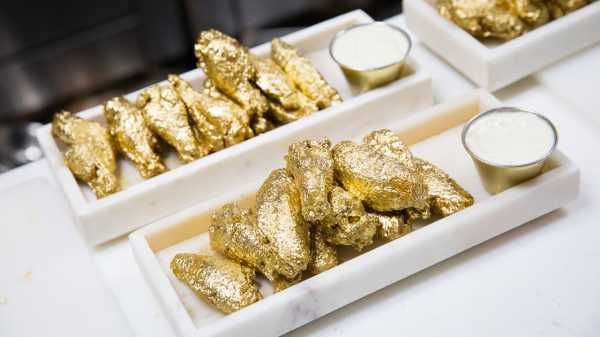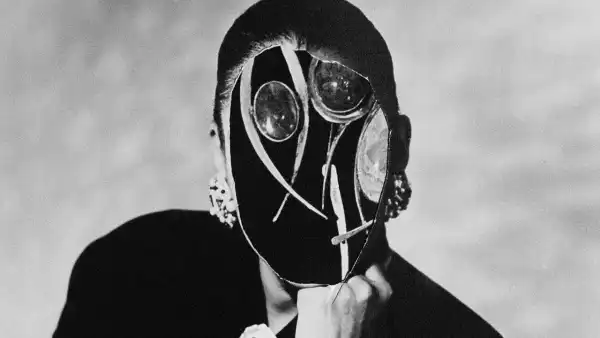
Last week, seemingly every time I opened my laptop or unlocked my phone, I was presented with the same video, in which a chicken drumette is fried amber-dark, then dunked and swirled in an iridescent, vividly yellow sauce that resembles molten gold. In the next frame, a mound of the metallic wings takes on even more glitter, as does the gloved hand of the cook guiding them, a dust storm of 24k. microparticles turning these hot wings into golden hot wings, which a person can order, if she so chooses, at the Ainsworth, a restaurant with locations in cities including New York, Hoboken, and Newark. The golden hot wings cost forty-five dollars for ten or ninety dollars for twenty, or you can drop a thousand dollars for a pile of fifty plus an aureate bottle of Armand de Brignac champagne.
The creative force behind this intestinal El Dorado is Jonathan Cheban, an erstwhile P.R. professional and self-propelled media personality who—despite an aggressive attempt to rebrand himself as a culinary influencer, complete with the nom de guerre Foodgōd—remains best known as a friend of Kim Kardashian. Brian Mazza, the president of the company that owns the Ainsworth, explains in the video, which was shot in one of the restaurant’s Manhattan locations, that he knows Cheban from the world of night life, and was inspired to work with him: “I said, ‘Bro, let’s do a collab.’ ” The video was produced by Insider, the life-style arm of the media company Business Insider. Once the wings are done with their powdered-gold shower, they land on a table in front of Cheban, who is sitting with an Insider reporter. He giddily bites into one, emerging with a foiled mouth, like an Egyptian queen, or a Spring 2016 Prada runway model, or a Diane von Furstenberg purse. “It’s starting,” he says solemnly. “The gold lipstick is starting.”
Over-the-top luxury foods are a reliable public-relations gambit for any attention-hungry restaurant—even in the years before the advent of Instagram, my e-mail inbox would fill up with thousand-dollar omelettes and millionaire Martinis, constructed with a laundry list of pricey ingredients. But, short of treating caviar like mashed potatoes or serving a whole white truffle to be eaten like an apple, it’s virtually impossible for a restaurant dish to reach a truly eye-popping price tag without an assist from the mineral world—like, say, the diamond that rested at the bottom of the glass of the the ten-thousand-dollar Martini once served at Vaucluse, a night club in Hollywood. (For a hundred grand, the club was happy to serve it with a bigger rock.)
Diamonds, though, are forever; once you finish your Martini, you’re left with a take-home souvenir. The whole point of eating Ainsworth’s wings (or the gold-leaf donut that was once sold in Brooklyn, or the maki roll dressed in gilded nori in Tokyo), by contrast, is the languid extravagance of destroying value. It’s like making a hot dog out of Kobe beef, or lighting your cigar using an early Picasso in lieu of a match. Well-heeled guests at the Burj Al Arab, a hotel in Dubai that bills itself as the most singularly luxurious in the world, can sip cappuccinos sweetened with gold-flecked sugar cubes and dusted with gold instead of nutmeg; according to the hotel’s director of engineering, an engaged couple once requested that the entirety of their six-tier wedding cake be covered in gold. To be safe to eat, gold needs to be in its purest form—24k. or 23k.—and even the highest-quality unalloyed gold leaf is so finely pressed that it’s nearly weightless; most baking-supply shops sell it for about ten cents per square inch. Cheban and the Ainsworth have said that each order of fifty chicken wings is covered with two hundred dollars’ worth of gold dust; at current commodity prices, that’s a whopping five grams of gold—think the weight of two pennies, or a woman’s wedding band.
The eating of gold (chrysophagy? aurivorism?) dates back to long before the stunt-food era—it has been consumed by medieval alchemists, pharaonic Egyptians, and Victorian aesthetes. The legendary Milanese chef Gualtiero Marchesi, one of the fathers of modern Italian cuisine, famously served saffron risotto topped with squares of gold leaf, an opulent echo of the rice’s vivid yellow hue. (The dish was so iconic that he wore it, in tiny replica, as a lapel pin.) Still, the megaphone of social media has allowed the recreational ingestion of gold to reach its peak as a form of conspicuous consumption. A person orders a platter of golden chicken wings to demonstrate that she is the sort of person who orders a platter of golden chicken wings. In that sense, the transfer of metallic dust from the chicken to the eater’s lips is ingenious: anyone who orders the dish gets a ready-made selfie out of it, too.
Gold, an inert metal, is nonreactive with the human body. (Though, according to one theory put forward in certain conspiracy-minded corners of the internet, ingesting gold enhances brain function to superhuman levels, and the Illuminati thus plot to keep the metal’s price high enough that the average person can’t afford to sprinkle it on food like salt.) The F.D.A. hasn’t rigorously studied the effects of the consumption of gold, but the E.U. classifies it as harmless. It is flavorless and odorless, and doesn’t break down during digestion. Your body Instagrams it, eats it, metabolizes it, and excretes it. This last step is not a trivial one: much like squid ink or beets, gold makes itself known on the way out. The artist Tobias Wong capitalized on this quality with his infamous work “Gold Pills,” from 2005—gelatin capsules filled with 24k. gold leaf, which were intended to be swallowed by the purchaser. Part of a larger commercial work called “Indulgences,” produced with the streetwear brand Just Another Rich Kid, Wong’s pills—which can be bought in an unlimited edition, a box of three for four hundred and twenty-five dollars—skewer and sucker the high-capital consumers who have turned out in force to buy them. The art is the act of selling the promise of golden shit, or maybe it’s the act of producing it.
Sourse: newyorker.com






